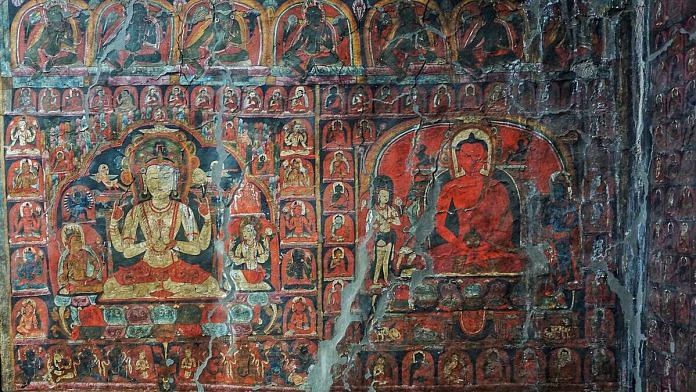The history of Kashmir, as a cultural unit, is not clear-cut. Indeed, as historian Robert E Fisher writes in the edited volume , “the name Kashmir was not generally limited to the small Himalayan valley until Kushan times, in the early centuries AD.” But it’s possible to trace the development of Kashmiri culture by looking at its art.
The earliest Kashmiri sculptures are in the naturalistic style of Gandhara, a cultural unit which included present-day northwest India and Pakistan. Gandhara was a prosperous, primarily Buddhist region that traded with Central Asia via Afghanistan. Its rulers, the Central Asian Kushans, founded cities in Kashmir such as Ushkur (originally Huvishkapura, after the Kushan king Huvishka).
For many centuries, Kashmir entered and left the orbit of various powers in the Indus and Gangetic Plains. It was only in the 7th century CE, with both Gandhara and the Gangetic Plains politically splintered, that Kashmir finally made its dazzling geopolitical—and cultural—debut.
This is a topic we’ve dealt with before in : under the conqueror (c. 724–760 CE), Kashmir is generally believed to have dominated a good chunk of the upper Gangetic Plains, and mounted expeditions into present-day Tajikistan and Tibet. Historian Tansen Sen, in his paper “Kaśmīr, Tang China, and Muktāpīḍa Lalitāditya’s Ascendancy Over the Southern Hindukush Region”, investigated this using contemporary Chinese sources. He found that, while Lalitaditya may have attacked the Gangetic Plains, the Kashmiri policy in Central Asia was far more restrained. Isolated from the old Gandharan trade routes, Kashmir was instead looking to Ladakh as a key corridor. Arab armies were advancing in this direction from the West, while Tibetans raided from the East. Chinese court documents suggest that, in pursuit of this goal, Lalitaditya allied with various Turkic city-states in Tajikistan, and offered Chinese armies logistical support in expeditions against the Tibetans. (Later Kashmiri poets would, however, in more jingoistic terms).
The success of this policy is, once again, visible in art. From around Lalitaditya’s time, Kashmiri art was no longer simply repurposing styles from elsewhere. Instead, in Buddhist monasteries in Ladakh and Tibet, we see the overwhelming dominance of Kashmiri artistic ideas, suggesting the movement of artists, sculptors, merchants, and monks. Many Kashmiri royals are known to have in Srinagar to host foreign scholars and teachers. At the same time, new bronze icons were developed to meet the needs of Tantric Buddhist elites in neighbouring regions: figures with rich jewellery, multiple arms and heads, and elongated eyes. Their facial features and hairstyles suggest that medieval Kashmir was confidently multiethnic and multicultural.
Art historian Rob Linrothe, writing in the volume , argues that in Tibet and Ladakh, even though artists were aware of ideas from Xinjiang and further east, they preferred Kashmiri styles. This means that if not for Kashmir, the visual world of a huge chunk of inner Asia would look entirely different.
By the 11th and 12th centuries, Kashmir was a culturally dazzling—if politically unstable—kingdom. Kashmiri poets, such as Bilhana, were active as far south as present-day Basavakalyan in Karnataka, and Kashmiri philosophers, such as Abhinavagupta, were known across the subcontinent. Kashmiri kings, however, were constantly vulnerable to the intrigues of landed aristocrats and religious institutions. Rulers such as Harsha (r. 1069–1101) began to , hiring Turk mercenaries. Turk and Mongol migrations and conquests continued, and, by the 1300s, Kashmir had been incorporated into the Islamicate, Persianate world.
With the advent of a Muslim ruling class, Kashmir’s sculptural and figural painting traditions waned. Yet, in other ways, the developments of prior centuries continued to endure. As historian Mushtaq A Kaw in ‘Central Asian Contribution to Kashmir’s Tradition of Religio-Cultural Pluralism’, Kashmir had a tradition of worshipping relics of the Prophet Muhammad—directly contiguous with practices in neighbouring Xinjiang. The idea very likely comes from the worship of Buddhist relics. Kaw also points to similarities in wedding rites, naming ceremonies, and ascetic traditions that Kashmir shared with a vast swathe of Central Asia.
While it’s possible that many such traditions predate the arrival of Islam, what seems beyond dispute is that Kashmir’s ancient connections were rejuvenated under Muslim rule. By the 17th century, Kashmir was once again firmly under the Gangetic orbit of the Mughal empire. Historian Showket Ahmad Mandloo, in ‘Trade and Commerce in Kashmir During the Mughal Period’, that the Mughal historian Abul Fazl describes no less than twenty-six routes traversing Kashmir. These connected it to “Ladakh, Tibet, Kashgar, Yarkand, China and Turkestan. The trade with Bhutan, Nepal and Bengal also took place by this route.” Armies, caravans, traders, mendicants, and artisans from all directions crisscrossed Kashmir. Kashmiri saffron, paper, fruits, and textiles found thriving markets in India and beyond, while Kashmiri Pandits and Sufis frequently found lucrative positions in Mughal service. Thousands of shawls were commissioned by Mughal aristocrats; Kashmir had easy access to raw materials (wool from Ladakh) as well as artisans, traders, and styles emerging from Central Asia. By connecting Indian buyers to Central Asian sellers, Kashmir’s prosperity exploded.
Peoples and cultures, languages and ethnicities—in today’s world of nation-states, we often see them as fixed, territorially-bounded, ascending and descending because of war or fervour. In particular, Kashmir’s transition from primarily Hindu to primarily Muslim is seen as a break from its past, providing justification for extremists to demand the involvement of nuclear-armed powers.
It seems we forget that Kashmir was always, for better or worse, the beating heart of inner Asia.
(Edited by Asavari Singh)








